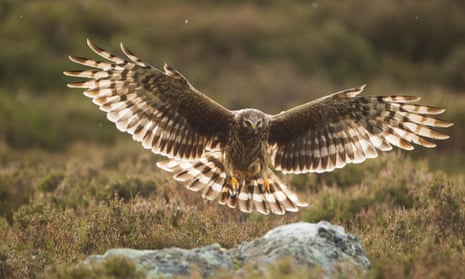People in Cumbria are being urged to watch over a pair of hen harriers who have begun nesting on a nature reserve as police investigate the disappearance of two other of the endangered raptors.
Two male hen harriers vanished from RSPB Geltsdale last week in what the police described as “suspicious circumstances”, just when both were providing nesting females with food. As a result both nests failed.
Hen harriers should be thriving on English uplands but conservationists say the birds are illegally persecuted, often on grouse moors because they kill red grouse and damage the lucrative driven grouse shooting industry.
According to Ruth Tingay, a raptor expert, 56 hen harriers have been confirmed as illegally killed or inexplicably “disappeared” since 2018, many of which were on or close to grouse moors.
Conservationists say the male birds are targeted in spring when they fly across moorland in search of food for their females, who are sitting on eggs. If the male disappears, the female cannot keep the eggs or chicks warm and find food, so the nest is abandoned.
“If you want to stop hen harriers breeding, this is a really smart way to do it,” said David Morris, the RSPB manager for Cumbria and north-east England. “You’re not going near the nests on an RSPB reserve but the males disappear and the nests fail.”
Last spring one male who was feeding two nesting females at Geltsdale disappeared in suspicious circumstances. Male hen harriers with nests on the reserve also disappeared at the same stage in 2015, 2017 and 2018. Geltsdale harriers’ only successful nesting attempt in the last 15 years was in 2016.
A new pair of hen harriers, including one bird fitted with a satellite tag, have made another nest on Geltsdale and Morris urged local people to help keep these birds and their nests safe.
Reserve managers protect the ground-nesting birds from foxes and other predators, and birds are also monitored from a distance by rangers and volunteers.
“All eyes are now on these birds,” said Morris. “Our priority is to make sure these birds are safe and we’re working very closely with the police to monitor them, their breeding sites and the habitat they are foraging over.”
Although it is difficult to prove illegal persecution when a bird disappears, Morris said it was very unlikely that multiple birds would die of natural causes precisely when they were provisioning nests. “It’s highly suspicious. Males are very bonded to the nest at this time of year. You might get the odd male that’s predated but you don’t get two males predated – and the same pattern happening year after year.”
He added: “There’s loads of habitat here, there’s loads of birds coming in, there’s loads of food. We can give them protection on our reserve but we can’t protect them all the time because these birds don’t stick to nature reserve boundaries.”

PC Samantha O’Key, of Cumbria police, appealed for information from the public following the disappearances. “These birds were in good health, in a perfect environment for them to thrive, with plenty of food. It is highly unlikely that the harriers have died of natural causes,” she said.
In 2013 the RSPB warned that hen harriers were close to extinction in England after the only two pairs failed to breed. But last year the hen harrier enjoyed its best breeding year in England for nearly two decades, with 60 chicks fledging from 19 nests. Ecologists calculate that the English uplands could naturally support 330 breeding pairs if the birds were not persecuted.
However, moorland owners say the breeding success in 2020 was a vindication of the government’s controversial brood management scheme, whereby chicks are removed from some nests on grouse moors, then reared in captivity and released elsewhere.
The grouse moor industry says this mechanism will stop illegal persecution because it reassures grouse shoots that hen harrier numbers will not be allowed to build up to such an extent that they make driven grouse shooting unviable.
In 2020 the British Association for Shooting and Conservation (BASC), the Moorland Association and other country sports groups issued a joint statement declaring “zero tolerance” for raptor persecution.
A spokesperson for the Moorland Association, said: “The missing hen harriers were not resident on land managed for grouse shooting and there is no evidence of wrongdoing. We would urge anyone who witnesses any suspicious activity to contact the police. The grouse shooting sector will continue to work with the police to stamp out incidents of raptor persecution where they occur.
“Contrary to the narrative pushed by campaigners, the UK’s bird of prey population is now well in excess of 250,000 adults, the highest level for a100 years. At least half of grouse moors in England now regularly see hen harriers on their land due to the predator-controlled environment provided and the plentiful food source available. Peregrines, owls and merlin are also doing well thanks to the concerted efforts of gamekeepers.”
